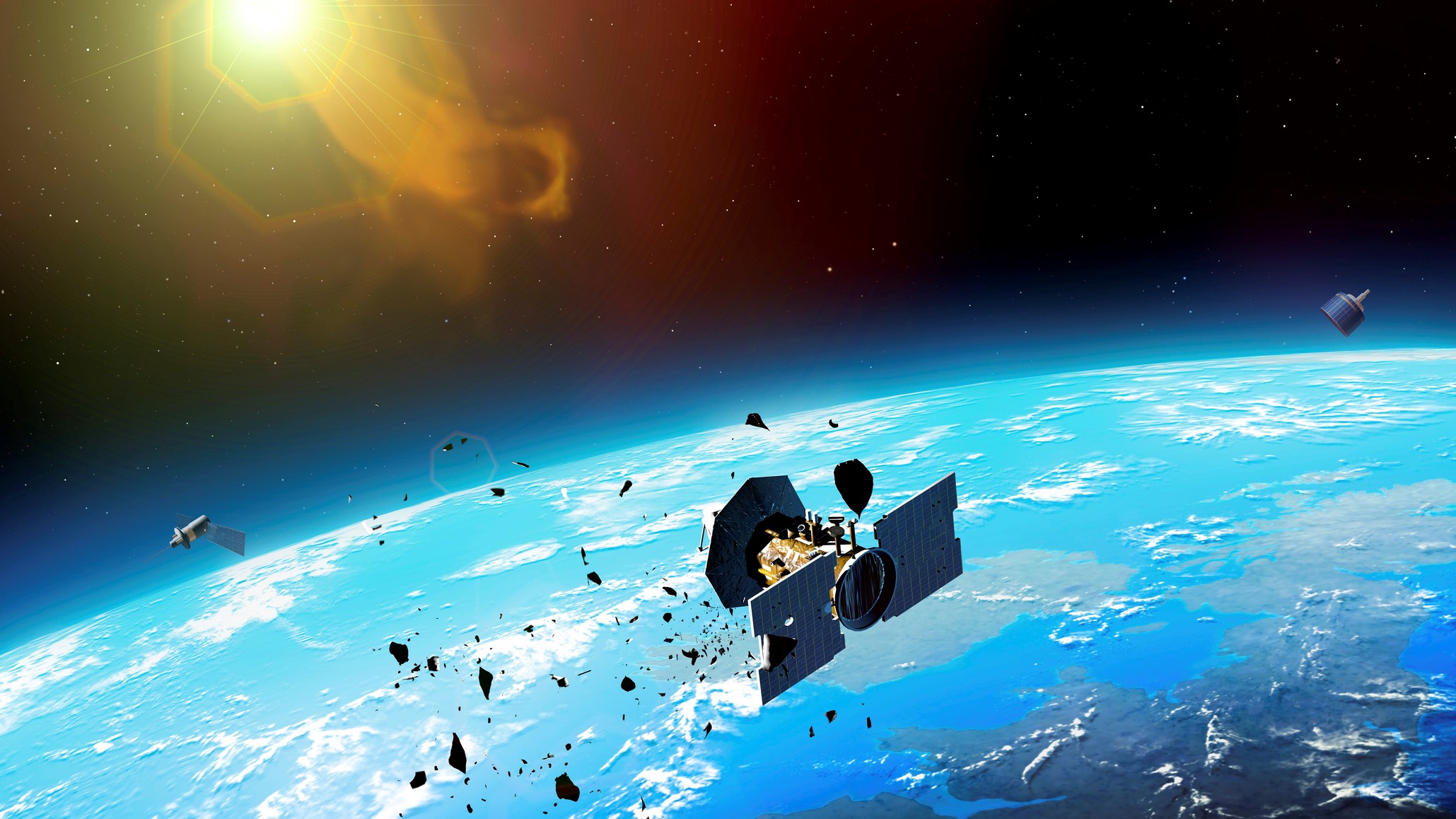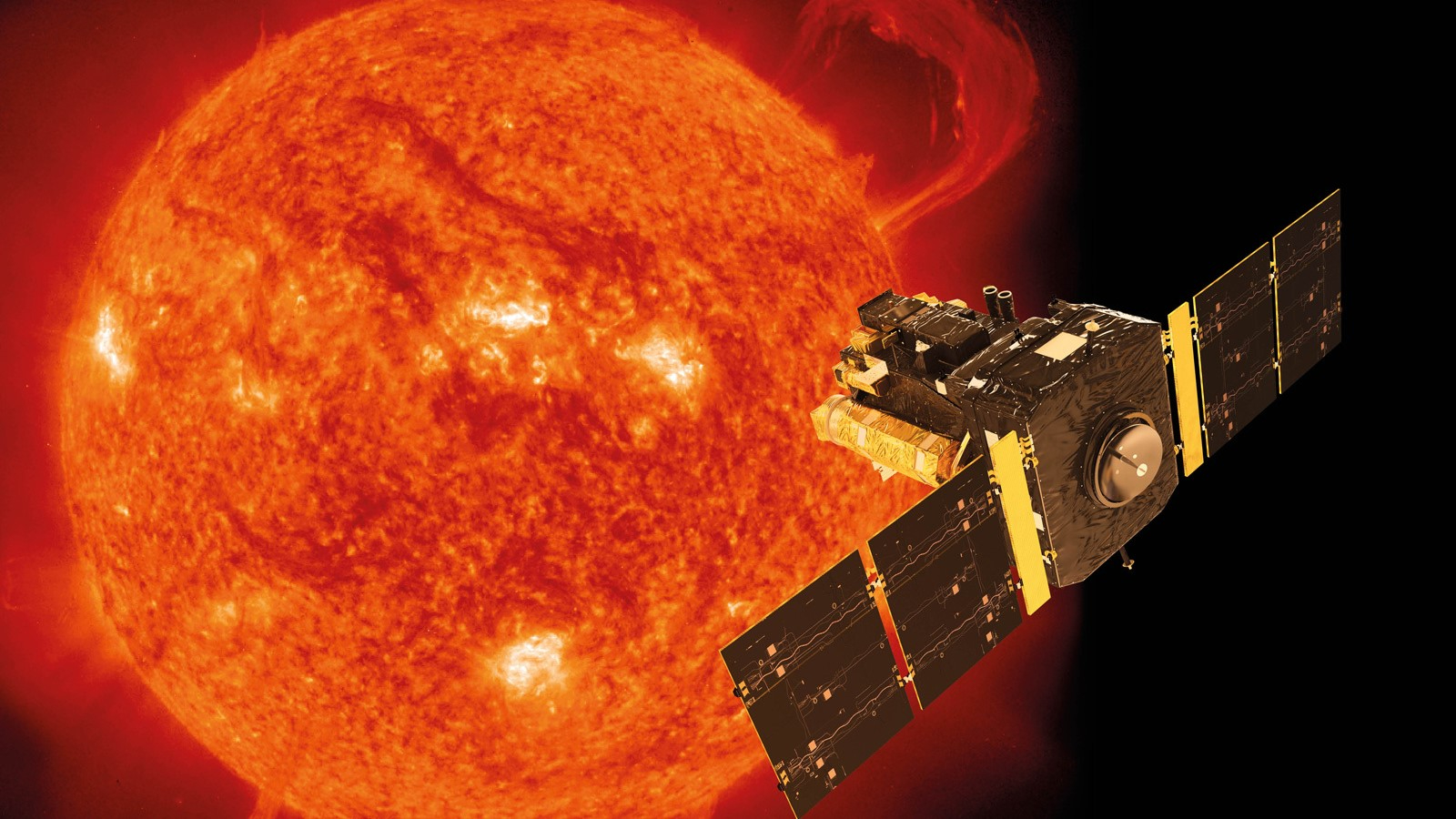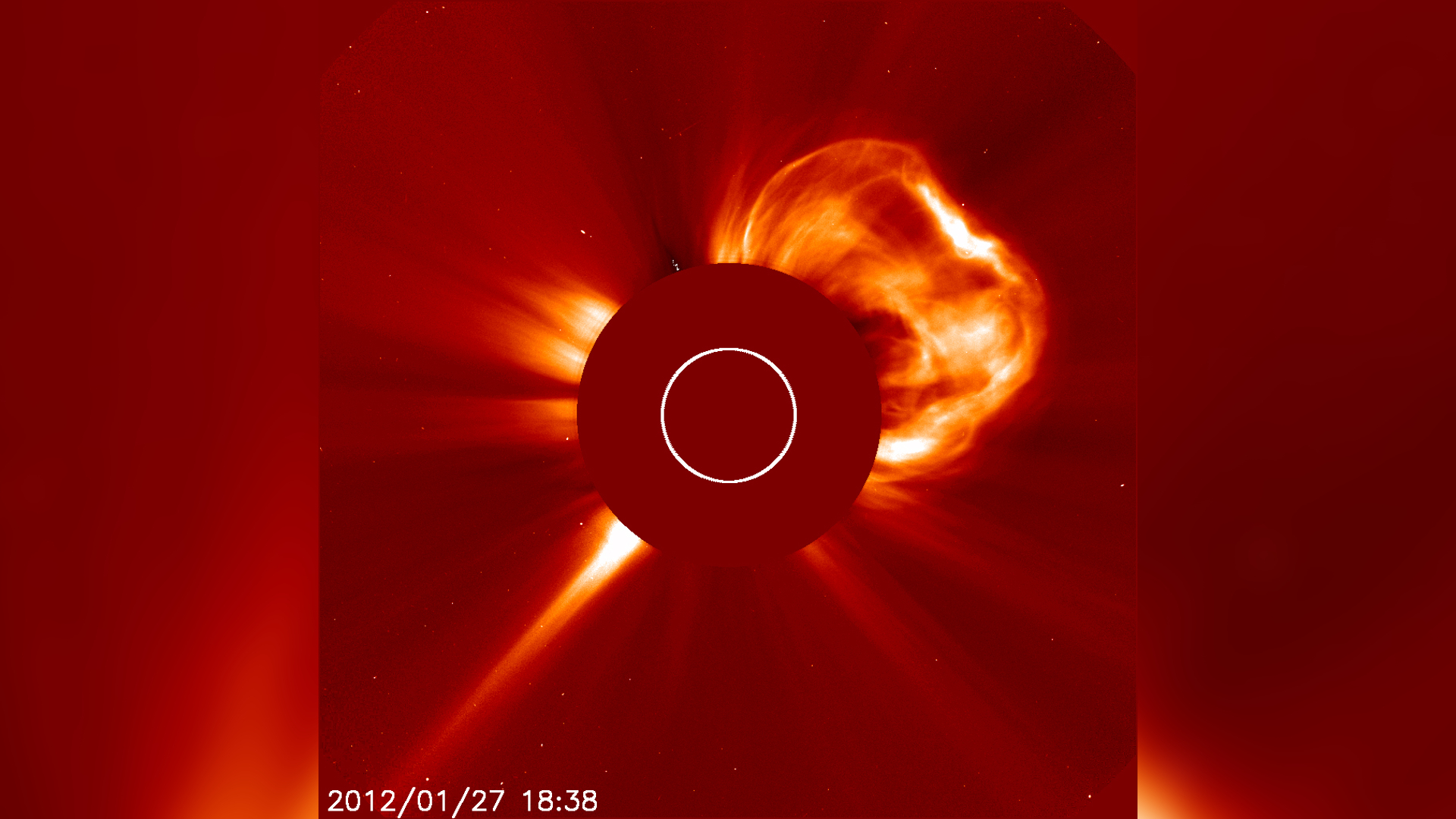Coronal mass ejections (CMEs) are large expulsions of plasma and magnetic field from the sun’s atmosphere — the corona.
Compared to solar flares — bursts of electromagnetic radiation that travel at the speed of light, reaching Earth in just over 8 minutes — CMEs travel at a more leisurely pace, relatively speaking. At their highest speeds of almost 1,900 miles per second (3,000 kilometers per second), CMEs can reach Earth in about 15 to 18 hours whilst slower CMEs traveling around 155 mi/s (250 km/s) can take several days to arrive, according to the Space Weather Prediction Center of the National Oceanic and Atmospheric Administration (opens in new tab) (NOAA).
These relatively slower travel times are useful as they give us more time to prepare for such an arrival. CMEs can wreak havoc with power grids, telecommunication networks and orbiting satellites and expose astronauts to dangerous doses of radiation. Conversely, CMEs are a welcomed visitor for skywatchers worldwide as they can trigger impressive aurora displays that are visible at latitudes beyond their “normal” polar range.
Related: How hot is the sun?
How do CMEs form?
Coronal mass ejections form similarly to solar flares — a result of the twisting and realignment of the sun’s magnetic field, known as magnetic reconnection, according to NOAA. When magnetic field lines “tangle” they produce strong localized magnetic fields which can break through the surface of the sun at active regions, subsequently generating CMEs.
CMEs usually take place around sunspot groups and are often accompanied by a solar flare, though the two don’t always occur in tandem. In fact, scientists are still not entirely sure how the two events are related, and according to University Corporation for Atmospheric Research’s (UCAR) Center for Science Education (opens in new tab) CMEs — like solar flares — are most common during solar maximum, a period in the sun’s 11-year cycle of activity when the star is at its most active. After CMEs are released, they swell in size as they travel away from the sun.
“Larger CMEs can reach a size comprising nearly a quarter of the space between Earth and the sun by the time it reaches our planet”, said NOAA in a statement.
If a CME is large enough and travels faster than the solar wind it generates a shock wave whereby accelerated charged particles travel ahead of the CME further disturbing space weather conditions and intensifying geomagnetic storms according to NOAA.
Effects of CMEs on Earth
Extensive auroral displays
(opens in new tab)
Aurora displays are formed when disturbances in Earth’s magnetic field funnel ions down towards Earth’s poles where they collide with atoms of oxygen and nitrogen in Earth’s atmosphere, creating dazzling aurora light shows around the polar regions. In the Northern Hemisphere the phenomenon is called the northern lights (aurora borealis), while in the Southern Hemisphere, it’s called the southern lights (aurora australis).
Usually, these dazzling light shows are confined to the polar regions but during large magnetic disturbances — triggered by a CME — auroras can be seen at much lower latitudes than they’re normally observed according to ESA (opens in new tab).
In 1859, the Carrington Event — a colossal solar storm triggered by a CME — resulted in aurora displays observed near tropical latitudes over Cuba, the Bahamas, Jamaica, El Salvador, and Hawaii, according to NASA Science (opens in new tab).
That being said, CMEs don’t always trigger extraordinary auroral displays, the degree of magnetic disturbance from a CME depends on the CME’s magnetic field and Earth’s. If the CME’s magnetic field is aligned with Earth’s, pointing from south to north the CME will pass on by with little effect. However, if the CME is aligned in the opposite direction it can cause Earth’s magnetic field to be reorganized (opens in new tab), triggering impressive auroral light shows.
Technological malfunctions
Large CMEs can cause technological malfunctions that are especially problematic in our modern world.
The Carrington Event in 1859 caused worldwide telegraph system failures. According to History.com (opens in new tab) there were even reports of operators receiving electric shocks and sparks showering from telegraph machines, setting papers ablaze. In 1989, a CME accompanied a solar flare that hit Earth, plunging the entire province of Quebec, Canada, into an electrical blackout that lasted 12-hours, according to a NASA statement (opens in new tab). The event cost Quebec’s utility company Hydro-Quebec at least $10 million in damages (opens in new tab).
But just how do CMEs cause all this disruption?
CMEs can also cause surges in electrical currents which overload power grids causing widespread blackouts. Also, according to NASA, CMEs can jostle Earth’s magnetic field which can impair radio transmissions and increase radio static in Earth’s ionosphere.
GPS systems are particularly vulnerable to disturbances in the ionosphere and GPS coordinates have been known to stray by tens of feet during a CME event. The disruption occurs because GPS uses radio signals to relay information between a satellite and a ground receiver. The radio signal passes through the ionosphere layer containing charged plasma that bends the path of the GPS signal in a similar fashion to lens bending light, according to NOAA’s Space Weather Prediction Center. Normally, GPS systems can compensate for this bending of the radio signal, leaving the accuracy of GPS unaffected. However, during a CME event, the ionosphere can be so severely disturbed that the GPS models cannot keep track of such changes and receivers can no longer calculate an accurate position.
Effects of CMEs in space

(opens in new tab)
How do CMEs affect satellites?
Earth-orbiting satellites are vulnerable to CMEs, particularly those in high geosynchronous orbits — which is where most communications satellites are found, according to NASA Goddard Space Flight Center (opens in new tab). When a CME triggers a geomagnetic storm, satellites can be struck by a high current discharged into the satellite or damaged when high-energy particles penetrate the satellite. As such, vulnerable satellites can be placed in “safe mode” to prevent damage to electronics.
A direct hit of a colossal geomagnetic storm like the one observed in 1859 — the Carrington Event — could take a heavy toll on our satellite fleet according to the research described (opens in new tab) in a NASA statement.
“A worst-case solar storm could have an economic impact similar to a category 5 hurricane or a tsunami,” said Dr. Sten Odenwald of NASA’s Goddard Space Flight Center, Greenbelt, Md.
“There are more than 900 working satellites with an estimated replacement value of $170 billion to $230 billion, supporting a $90 billion-per-year industry. One scenario showed a ‘superstorm’ costing as much as $70 billion due to a combination of lost satellites, service loss, and profit loss.”
SpaceX has already witnessed firsthand the damage space weather can do when a geomagnetic storm destroyed 49 Starlink satellites worth over $50 million, in Feb. 2022.
Can CMEs harm astronauts?
In low-Earth orbit, astronauts receive higher doses of radiation than we do on Earth but they are still mostly protected by the magnetosphere according to a statement from NASA (opens in new tab).
The real danger to astronauts comes if they stray from the safety of the magnetosphere, for example, to explore the surface of the moon or Mars. Upon such an expedition — outside Earth’s “protective shields” — they are vulnerable to dangerous space weather events such as CMEs. According to NASA, if a CME-driven shock wave were to hit an unprepared astronaut exploring the lunar or martian surface, they would be hit with as much radiation as 300,000 simultaneous chest X-rays. This would have lethal consequences as it would only take 45,000 simultaneous chest X-rays to kill you.
How can we forecast CMEs?

(opens in new tab)
Solar weather can have drastically expensive consequences, it is, therefore, important to increase our understanding, monitoring and predictions of such events.
Luckily for us, CMEs take several hours, sometimes days, to reach Earth. This gives us some time to prepare for their arrival.
Various organizations keep a watchful eye on the sun and report any changes in surface characteristics that could infer a CME ejection such as an increase in solar activity and solar flare ejections. If a strong M or X-class solar flare is detected it is likely that it will be accompanied by a CME, but not always, according to SpaceWeatherLive.com.
SWPC forecasters use various parameters — size, speed and direction — inferred by orbital satellites’ coronograph imagery to determine the likelihood of a CME hitting Earth.
A coronagraph is a specialized instrument used to block out the light of the sun so scientists can observe the outermost layer — the corona. It mimics the natural phenomenon of a solar eclipse when the moon’s shadow covers the bright center allowing the corona to be observed.
According to NOAA, forecasters primarily use NASA and ESA’s Solar and Heliospheric Observatory’s (SOHO) coronagraph — the Large Angle and Spectrometric Coronagraph (LASCO) to analyze CMEs and determine the likelihood of an Earth impact.

(opens in new tab)
On the frontline of CME detection is the Deep Space Climate Observatory (opens in new tab) (DSCOVR) satellite that is stationed at the first Lagrange point — L1 — between Earth and the sun at about 1 million miles (1.6 million km) from Earth.
DSCOVR monitors any changes in the interplanetary magnetic field (IMF) strength and solar wind speed which are vital to the accuracy and responsiveness of NOAA’s space weather alerts and forecasts.
From its parking spot at L1, the DSCOVR satellite can provide between 15 to 60 minutes of advanced warning before a CME reaches Earth. When an Earth-bound CME is detected, the SWPC alerts vulnerable groups such as power companies, satellite companies and airlines to take appropriate measures. With advanced warning, utility companies can redirect power loads to protect the grids from being overloaded when the CME hits, satellites can be placed into “safe” mode and planes can be redirected.
ESA’s Vigil mission (opens in new tab) hopes to add another solar defender to Earth’s aid by the mid-2020s according to ESA. Vigil will monitor the sun from Lagrange 5, approximately 93 million miles (150 million kilometers) from Earth. The spacecraft will be positioned so it can keep an eye on the “side” of the sun. It will monitor solar conditions before they rotate around to face Earth in a bid to give us advanced warning of possibly hazardous solar activity.
Additional resources
Interested in reading more about what impacts large solar flares and CMEs might have on astronauts on the moon, check out this article from NASA (opens in new tab). Explore more effects of energized space weather and the hazards of space travel with Tufts University (opens in new tab). Want to keep an eye on current geomagnetic activity levels for yourself? The British Geological Survey (opens in new tab) has got you covered you can also sign up for their geomagnetic disturbance alert emails (opens in new tab).
Bibliography
Coronal mass ejections. NOAA / NWS Space Weather Prediction Center (opens in new tab). Retrieved May 20, 2022.
DSCOVR: Deep Space Climate Observatory. NESDIS (opens in new tab). Retrieved May 20, 2022.
Mendez, B., Peticolas, L., & Hauck, K. (August 12, 2004). Solar flares and coronal mass ejections. NASA. Retrieved May 20, 2022 (opens in new tab).
NASA. The impact of flares (opens in new tab). NASA. Retrieved May 20, 2022.
Odenwald, S. (March 13, 2009). The Day the sun brought darkness. (opens in new tab) NASA. Retrieved May 20, 2022.
Solar Orbiter images (opens in new tab) first coronal mass ejections. ESA. (May 17, 2021.). Retrieved May 20, 2022.
Steigerwald, B., & Weintraub, R. A. (April 1, 2006.). Safeguarding our satellites (opens in new tab) from the sun. NASA. Retrieved May 20, 2022.
UCAR Center for Science Education. Coronal Mass Ejection (CME) | Center for Science Education (opens in new tab). Retrieved May 20, 2022.
What is a coronal mass ejection (CME)? SpaceWeatherLive (opens in new tab). Retrieved May 20, 2022.

